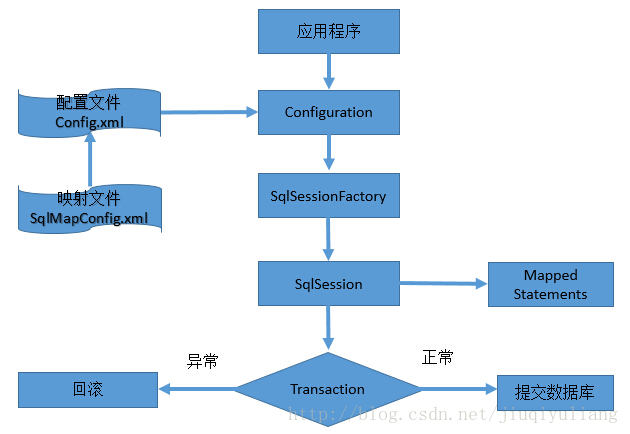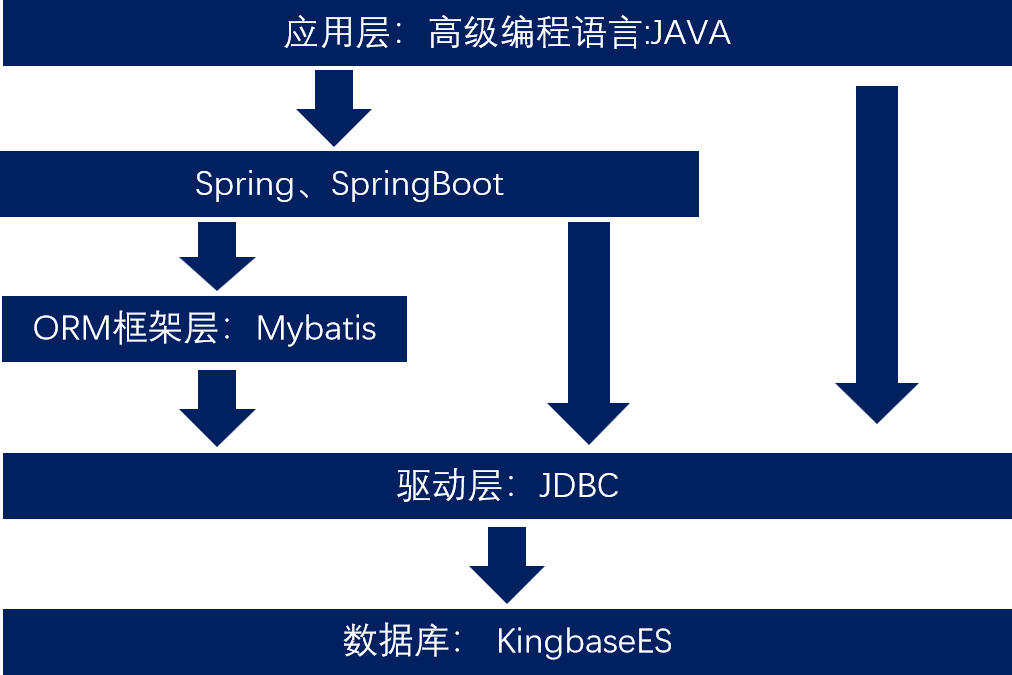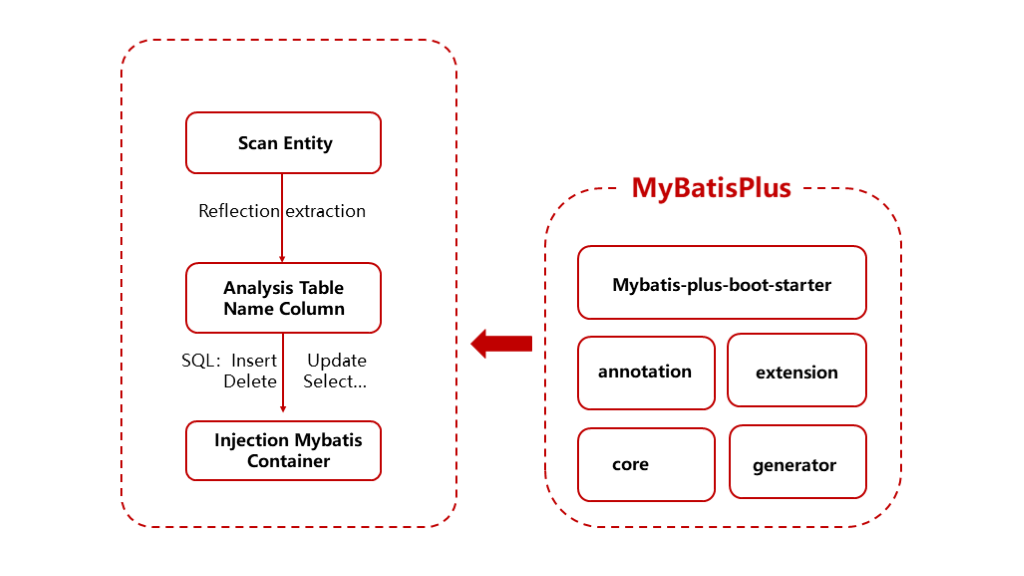人大金仓数据库KingbaseES 支持的开发框架介绍和使用之二 之Mybaits篇
在property 中增加如下声明:jdbc.username=登录名jdbc.password=登录密码MyBatis-Plus 是基于 MyBatis 的增强工具库,旨在简化 MyBatis 的开发流程,提供更便捷的数据库访问操作。它是对 MyBatis 的扩展,提供了一系列的增强功能和便利的开发特性。MyBatis-Plus 的主要特点包括:简化的 CRUD 操作:MyBatis-Plus
1.KES与Mybaits
1.1 Mybaits简介
MyBatis 是一个开源的持久层框架,它提供了将 SQL 语句与 Java 对象之间的映射关系进行配置的功能。它的目标是简化数据库访问的开发过程,提供灵活性和高性能。
MyBatis 的核心思想是将 SQL 语句与 Java 对象进行映射,通过配置文件或注解的方式,将 SQL 语句与数据库操作进行绑定。开发人员可以通过编写简单的 SQL 语句,将数据的增删改查操作与 Java 对象的属性进行关联,从而实现数据的持久化操作。
MyBatis 提供了以下主要特点:
灵活的 SQL 映射:MyBatis 允许开发人员使用 XML 配置文件或注解的方式,将 SQL 语句与 Java 对象进行映射。这样可以灵活地编写和管理 SQL 语句,使得开发人员可以更好地控制和优化数据库访问。
参数映射:MyBatis 支持将 Java 对象的属性与 SQL 语句中的参数进行映射,开发人员可以直接在 SQL 语句中使用对象的属性,而不需要手动拼接 SQL 语句。
结果映射:MyBatis 支持将 SQL 查询结果与 Java 对象进行映射,开发人员可以将查询结果直接映射为 Java 对象,简化了数据的处理过程。
缓存支持:MyBatis 提供了一级缓存和二级缓存的支持,可以提高数据库访问的性能。
插件扩展:MyBatis 允许开发人员编写插件来扩展框架的功能,可以在 SQL 执行前后进行拦截和处理,实现自定义的功能扩展。
总的来说,MyBatis 是一个简单、灵活且功能强大的持久层框架,它通过将 SQL 语句与 Java 对象进行映射,提供了方便的数据库访问方式,同时也提供了缓存支持和插件扩展等功能,使得开发人员可以更高效地进行数据库操作。
1.2 Mybaits原理
Mybatis 是非常流行的ORM框架,主要着力点在于 POJO 与 SQL 之间的映射关系。然后通过映射配置文件,将SQL所需的参数,以及返回的结果字段映射到指定 POJO 。相对Hibernate“O/R”而言,Mybatis 是一种“Sql Mapping”的ORM实现。
配置文件:配置数据库连接参数。
映射文件:配置SQL语句和JAVA核心类SqlSession的映射。

1.3 Mybatis支持的驱动形态
|
框架名称 |
方言包 |
支持的驱动形态 |
|
Mybatis |
- |
KES、PG形态 |
1.4 Mybatis使用场景
Mybatis可以单独使用,直接操作jdbc。也可以由spring,spring-boot等框架整合使用。 Mybatis主要应用于需求多变的互联网项目,例如电商项目等。

1.5 Mybatis与KES配置使用说明
Mybatis的jar包可以从官方网站下载,Mybatis所使用的JDBC包kingbase8-8.6.0.jar位于$KINGBASE_HOME/Interface/jdbc目录下。使用时将Mybatis包和JDBC包导入到项目的Libraries中并定义相关配置项即可。
1.5.1 定义Mybatis配置文件
根据用户选择,更改配置文件。在config.xml中配置JDBC的驱动信息参数,数据库服务器信息参数和登陆用户信息参数。当然,这些参数也可以根据用户应用需求,单独生成property文件,针对不用的应用场景,导入不同的属性文件。这里以property为例说明下config.xml的配置使用。
在property 中增加如下声明:
jdbc.driverClassName=com.kingbase8.Driver
jdbc.url=jdbc:kingbase8://localhost:54321/TEST
jdbc.username=登录名
jdbc.password=登录密码
在config.xml 中增加如下声明:
<environments default="development">
<environment id="development">
<transactionManager type="JDBC"/>
<dataSource type="POOLED">
<property name="driver" value="${jdbc.driverClassName}"/>
<property name="url" value="${jdbc.url}"/>
<property name="username" value="${jdbc.username}" />
<property name="password" value="${jdbc.password}" />
</dataSource>
</environment>
</environments>1.5.2 配置mapper.xml
主要是配置SQL映射关系,根据用户的需求,自定义映射关系。这里以一个简单的配置为例。
在mapper.xml 中增加如下声明:
<mapper namespace="com.test.interfaces.MybatisDao">
<update id="dropTable">
DROP TABLE IF EXISTS ${sql} CASCADE
</update>
<update id="createNewTableMap" parameterType="java.util.HashMap">
${sql}
</update>
<resultMap id="NumTableMap" type="NumEntity">
<result column="id" property="userId" />
<result column="age" property="userAge" />
<result column="name" property="userName" />
<result column="wage" property="userWage" />
<result column="cost" property="userCost" />
</resultMap>
<select id="selectNumTable" resultMap="NumTableMap">
select * from t_num
</select>
<select id="selectNumTableByID" parameterType="int"
resultMap="NumTableMap">
select * from t_num where id=#{value}
</select>
<select id="selectNumTableByAge" parameterType="int"
resultMap="NumTableMap">
select * from t_num where age=#{value}
</select>
<select id="selectNumTableByName" parameterType="string"
resultMap="NumTableMap">
select * from t_num where name=#{value}
</select>
<insert id="insertNumTable" parameterType="NumEntity"
keyProperty="userId">
insert into t_num(id,age,name,wage,cost)
values(#{userId},#{userAge},#{userName},#{userWage},#{userCost})
</insert>
<update id="updateNumTableById" parameterType="NumEntity" >
update t_num set age=#{userAge},name=#{userName},wage=#{userWage},
cost=#{userCost}where id=#{userId}
</update>
<delete id="deleteNumTableById" parameterType="int">
delete from t_num where id=#{value}
</delete>
<delete id="deleteNumTable">
delete from t_num
</delete>
</mapper>1.6 Mybatis程序示例
1.6.1 接口和实例开发示例
- 在Java中读取property和config属性,配置到sqlSessionFactory
@BeforeClass
public static void setUpClass() throws Exception {
InputStream fis = null;
InputStream inputStream = null;
try {
/* 创建一个 sqlSessionFactory */
Properties prop = new Properties();
fis = Resources.getResourceAsStream("propertty");
prop.load(fis);
inputStream = Resources.getResourceAsStream("MyConfig.xml");
sqlSessionFactory = new SqlSessionFactoryBuilder().build(inputStream,
"development", prop);
} catch(Exception e) {
e.printStackTrace();
}
}- 在Java中配置mapper.xml对应的namespace,为Interface类型
public interface MybatisDao {
int createNewTableMap(Map<String, Object> param);
int dropTable(Map<String, Object> param);
/*
* new number table
*/
public List<NumEntity> selectNumTable();
public NumEntity selectNumTableByID(int id);
public List<NumEntity> selectNumTableByAge(int age);
public List<NumEntity> selectNumTableByName(String name);
public void insertNumTable(NumEntity user);
public void updateNumTableById(NumEntity user);
public void deleteNumTableById(int id);
public void deleteNumTable();
}- 在Java中进行表的查询操作
public void testNumTable() {
SqlSession session = sqlSessionFactory.openSession();
int i = 1;
try {
MybatisDao userOperation = session.getMapper(MybatisDao.class);
List<NumEntity> users = userOperation.selectNumTable();
for (NumEntity user : users) {
System.out.println(user);
Assert.assertEquals(i, user.getId());
Assert.assertEquals(AGE+i, user.getUserAge());
Assert.assertEquals(name[i], user.getUserName());
Assert.assertEquals("yes",WAGE+(double)(i*100)/(double)(3.0),
user.getUserWage(),0.000001);
Assert.assertEquals("yes",COST+(double)(i*100)/(double)(3.0),
user.getUserCost(),0.01);
i++;
}
} finally {
session.close();
}
}- 在Java中进行表的插入操作
public void testInsertNumTable() {
int i = 1 ;
SqlSession session = sqlSessionFactory.openSession();
try {
MybatisDao userOperation = session.getMapper(MybatisDao.class);
NumEntity user = new NumEntity();
name[1] = "张三";
name[2] = "李四";
name[3] = "王五";
name[4] = "赵二";
name[5] = "小北";
name[6] = "小东";
name[7] = "小西";
name[8] = "小南";
name[9] = "小明";
for (i=1;i<10;i++) {
user.setId(i);
user.setUserAge(AGE+i);
user.setUserName(name[i]);
user.setUserWage(WAGE+(double)(i*100)/(double)(3.0));
user.setUserCost(COST+(double)(i*100)/(double)(3.0));
userOperation.insertNumTable(user);
session.commit();
System.out.println(user);
}
} finally {
session.close();
}
}- 在Java中进行表的更新操作
public void testUpdateNumTable() {
int i = 1 ;
SqlSession session = sqlSessionFactory.openSession();
try {
MybatisDao userOperation = session.getMapper(MybatisDao.class);
NumEntity user = new NumEntity();
/* 更新一行新的数据id=1 */
user = userOperation.selectNumTableByID(1);
user.setUserAge(AGE+i);
user.setUserName(name[0]);
user.setUserWage(WAGE+(double)(i*100)/(double)(3.0));
user.setUserCost(COST+(double)(i*100)/(double)(3.0));
userOperation.updateNumTableById(user);
session.commit();
} finally {
session.close();
}
}- 在Java中进行表的删除操作
public void testDeleteNumTable() {
int i = 1 ;
SqlSession session = sqlSessionFactory.openSession();
try {
MybatisDao userOperation = session.getMapper(MybatisDao.class);
userOperation.deleteNumTable();
session.commit();
} finally {
session.close();
}
}1.6.2 存储过程的使用
- 如果开发过程中需使用数据库的存储过程,可在mapper.xml中增加如下内容:
<select id="getPerson" resultType="java.util.Map"
statementType="CALLABLE">
{
call getPerson(
#{a,mode=IN,jdbcType=INTEGER},
#{b,mode=OUT,jdbcType=VARCHAR},
<!-- #{param2,mode=OUT,javaType=ResultSet,jdbcType=CURSOR,resultMap=cursorMap,typeHandler=org.apache.ibatis.type.ObjectTypeHandler} -->
#{param2,mode=OUT,javaType=ResultSet,jdbcType=OTHER,resultMap=cursorMap}
)
}
</select>- 创建表和数据:
create or replace function getPerson(b out refcursor)
as $$
begin
open b for select * from person;
end;
$$ language plsql;- 调用存储过程:
Map<String, Object> map = mapper.getPerson2(null, null, null);
ResultSet o = (ResultSet) map.get("getperson2");
o.next();
System.out.println(o.getString(1));
System.out.println(o.getString(2));
System.out.println(o.getString(3));1.7 注意事项
- KingbaseES支持array数据类型,在MyBatis中需要增加ArrayTypeHandler来处理这一特殊类型;
- KingbaseES支持json数据类型,在Mybatis中需要增加JsonTypeHandler来处理这一特殊类型;
- KingbaseES支持hstore数据类型,在Mybatis中需要增加HstoreTypeHandler来处理这一特殊类型;
- KingbaseES支持XML数据类型,在Mybatis的映射中,需要对xml数据类型做标注,如:
insert into t_xml(value) values ((#{content})::xml)
- KingbaseES适配Mybatis的pagehelper插件时,由于无法通过连接自动获取数据库类型,需要将helperDialect设置成postgresql,配置如下:
<plugins>
<!-- com.github.pagehelper为PageHelper类所在包名 -->
<plugin interceptor="com.github.pagehelper.PageInterceptor">
<property name="helperDialect" value="postgresql" />
</plugin>
</plugins>1.8 常见问题
Mybatis设置SQL超时时间
mybatis如果不指定,默认超时时间是不做限制的,默认值为0.
mybatis sql配置超时时间有两种方法:
1、全局配置
在mybatis配置文件的settings节点中,增加如下配置
<settings> <setting name="defaultStatementTimeout" value="25"/></settings>
以秒为单位的全局SQL超时时间设置,当超出了设置的超时时间时,会抛出SQLTimeoutException
2、Mapper XML配置
在mapper xml文件中对具体一个sql进行设置,方法为在select/update/insert节点中配置timeout属性,超时时间并只作用于这一个sql.
<insert
id="insert"
parameterType="com.test.abc.Person"
flushCache="true"
statementType="PREPARED"
keyProperty=""
keyColumn=""
useGeneratedKeys=""
timeout="10">- Mybatis非法long值问题
答:1:这个问题是由于V7的JDBC默认把TEXT类型对应为LONGVARCHAR,而Mybatis又把LONGVARCHAR类型默认按照CLOB对象处理,造成和Hibernate非法long值的情形类似,但是Mybatis没有提供方言机制,所以无法像Hibernate那样同过方言包控制,只能把V7的JDBC的TEXT类的值对应到Varchar来处理,就解决非法值问题。
2:如果用新的JDBC还出此问题,说明用户自己把string类型的jdbcType手动设置为LONGVARCHAR了。解决办法:就是把jdbcType去掉或者设置为VARCAHR即可。
- Mybatis 报错:字段的类型为 TEXT, 但表达式的类型为 BYTEA你需要重写或转换表达式
答:1:这个问题需要查看出错SQL的mapper文件,需要知道mapper中参数是否指定了类型,从正常逻辑上来说不应该出现这样的转换,应该可通过调整参数类型解决。
2:这个也可以从JDBC入手,把所有Bind参数设置Oid.BYTEA的全都改为0,让服务器自己推断类型。
- Mybatis 控制JDBC底层不走预编译
答:在mapper文件中可以使用statementType标记使用什么的对象操作SQL语句。 statementType:标记操作SQL的对象 ,如statementType=”STATEMENT”
要实现动态传入表名、列名,需要做如下修改,sql里的所有变量取值都改成${xxxx},而不是#{xxx}
取值说明:
1、STATEMENT:直接操作sql,不进行预编译,获取数据:$—Statement
2、PREPARED:预处理,参数,进行预编译,获取数据:#—–PreparedStatement:默认
3、CALLABLE:执行存储过程————CallableStatement
- Mybatis 控制Bind参数
答:#{}:相当于JDBC中的PreparedStatement,走Bind报文。
${}:是输出变量的值,字串替换,不走Bind。
简单说,#{}是经过预编译的,是安全的;${}是未经过预编译的,仅仅是取变量的值,是非安全的,存在SQL注入。
- Mybatis 使用pagehelper插件
Mybatis使用该插件需要将helperDialect设置成postgresql,如不指定,会报错:com.github.pagehelper.PageException:无法自动获取数据库类型,请通过helperDialect参数指定!
1.直接使用Mybatis设置如下:
<plugins>
<!-- com.github.pagehelper为PageHelper类所在包名 -->
<plugin interceptor="com.github.pagehelper.PageInterceptor">
<property name="helperDialect" value="postgresql" />
</plugin>
</plugins>2.springboot整合mybatis使用如下:
在pom文件中引入Pagehelper分页插件:
<!-- 分页插件 -->
<dependency>
<groupId>com.github.pagehelper</groupId>
<artifactId>pagehelper-spring-boot-starter</artifactId>
<version>1.2.5</version>
</dependency>配置分页插件,打开application.properties,添加如下配置信息:
#分页插件
pagehelper.helper-dialect=postgresql
如果需要通过url自动识别方言,配置dialectAlias参数,具体的实现类和pg的映射保持一致即可,根据不同的pagehelper版本来定。以pagehelper-5.1.10为例,如下:
pagehelper:
dialectAlias: kingbase8=com.github.pagehelper.dialect.helper.HsqldbDialect
- Mybatis 使用自动返回主键功能
该功能使用在V7仅支持insert语句
建表语句,要求表含有主键,且主键自增:
create table t_user (id int identity primary key,username text,password text,sex boolean);
在mapper文件里配置:
<!-- useGeneratedKeys:(仅对 insert 有用)这会告诉 MyBatis 使用 JDBC 的getGeneratedKeys方法来取出由数据内部生成的主键。默认值: false。 -->
<!--keyProperty:(仅对 insert有用)标记一个属性, MyBatis 会通过 getGeneratedKeys或者通过 insert 语句的 selectKey 子元素设置它的值。默认:不设置。 -->
<insert id="insertUser" useGeneratedKeys="true" keyProperty="id">
insert into t_user (username,password,sex) values
(#{username},#{password},#{sex})
</insert>注意:如果使用tk-mybatis提供的mapper接口,V7需要mapper包的版本在3.4.0及以上,否则使用update相关的接口时,会报“不能返回generatedkeys或没有指定返回”的错误。
- Mybatis配置databaseId
<!--数据库厂商标示 -->
<databaseIdProvider type="DB_VENDOR">
<property name="KingbaseES" value="kingbase"/>
</databaseIdProvider>
<select id="getAllProduct" resultType="product" databaseId="kingbase">
SELECT * FROM product3
</select>- Mybatis使用匿名块插入语句报错
Mybatis中使用begin insert ...;insert...; end;格式的语句插入数据,报无法识别的GBK编码:'0x00'或者指定了连接参数prepareThreshold=-1报Can‘t change resolved type for param:1 from 1043 to 25.该问题属于plsql问题需要升级数据库版本。
在升级数据库版本后,如果出现类型转换错误,则使用强转(例如?::bytea)把其转换为对应类型,出现该错误的原因为匿名块无法识别oid绑定类型为0的参数,会将其默认识别为text,传给下层时无法转换为对应类型,就会报错。特别地,如果字段类型为二进制,如bytea、blob,如果参数内容有数据库无法识别的编码的话,转换成text就会报无法转换的编码错误,此时指定连接参数bytestype=bytea即可。
- Mybatis使用ScriptRunner执行含plsql的sql脚本报错
- ScriptRunner默认按照自定义的分隔符每行执行,分隔符默认为分号,如果sql脚本中包含plsql语句,按照分号分割出来的语句是不正确的,所以可以使用setDelimiter(String)来设置自定义的分隔符,如设置分隔符为"/",则sql脚本中的每条语句后都添加"/",ScriptRunner将会按照此对语句进行分割,连接KingbaseES时,普通语句之间无需使用分隔符,驱动会对普通语句进行分割;
- 或者可以通过runner.setSendFullScript(true);设置将sql脚本一次发送,但是由于驱动不会对包含plsql的多语句进行分割,所以会报”无法插入多条命令到一个准备好的语句中“,此时指定jdbc连接参数preferQueryMode=simple走简单查询报文即可。
- Mybatis使用游标的注册方式
<select id="selectTempManualDataTest" statementType="CALLABLE"> {#{out_return,mode=OUT,javaType=ResultSet,jdbcType=OTHER, resultMap=tempMap} = call proc_aaaaa() } </select>
注意:
1. jdbcType只能设置为OTHER,不能设置为CURSOR,Mybatis的CURSOR的值为-10,是OracleCURSOR的值,不是Types.REF_CURSOR的值,我们不支持;
2. 如果没有设置javaType的类型,返回值的类型为ResultSet,如果设置了返回值的类型为ResultSet,则返回值为List对象。
- Mybatis写json类型示例
建表:
create table t_json(id serial,content json);
实体类:
package com.test.entity;
public class JsonEntity {
private int id;
private Object fcontent;
public int getId() {
return id;
}
public void setId( int id) {
this.id = id;
}
public Object getContent() {
return fcontent;
}
public void setContent(Object b) {
this.fcontent = b;
}
@Override
public String toString() {
return "id=" + this.id ;
}
}
JsonTypeHandler.java
package com.test.handler;
import java.sql.CallableStatement;
import java.sql.PreparedStatement;
import java.sql.ResultSet;
import java.sql.SQLException;
import org.apache.ibatis.type.BaseTypeHandler;
import org.apache.ibatis.type.JdbcType;
import com.test.utils.JsonUtil;
// 继承自BaseTypeHandler<Object> 使用Object是为了让JsonUtil可以处理任意类型
public class JsonTypeHandler extends BaseTypeHandler<Object> {
@Override
public void setNonNullParameter(PreparedStatement ps, int i, Object parameter,
JdbcType jdbcType) throws SQLException {
ps.setString(i, JsonUtil.stringify(parameter));
}
@Override
public Object getNullableResult(ResultSet rs, String columnName)
throws SQLException {
return JsonUtil.parse(rs.getString(columnName), Object.class);
}
@Override
public Object getNullableResult(ResultSet rs, int columnIndex) throws SQLException {
return JsonUtil.parse(rs.getString(columnIndex), Object.class);
}
@Override
public Object getNullableResult(CallableStatement cs, int columnIndex)
throws SQLException {
return JsonUtil.parse(cs.getString(columnIndex), Object.class);
}
}
JsonUtil.java
package com.test.utils;
import java.io.OutputStream;
import java.text.SimpleDateFormat;
import org.apache.ibatis.logging.Log;
import org.apache.ibatis.logging.LogFactory;
import org.codehaus.jackson.map.DeserializationConfig;
import org.codehaus.jackson.map.ObjectMapper;
import org.codehaus.jackson.map.annotate.JsonFilter;
import org.codehaus.jackson.map.ser.impl.SimpleBeanPropertyFilter;
import org.codehaus.jackson.map.ser.impl.SimpleFilterProvider;
import org.springframework.core.annotation.AnnotationUtils;
import org.codehaus.jackson.map.SerializationConfig;
public class JsonUtil {
private static Log log = LogFactory.getLog(JsonUtil.class);
private static ObjectMapper objectMapper = null;
static {
objectMapper = new ObjectMapper();
objectMapper.setDateFormat(new SimpleDateFormat("yyyy-mm-dd"));
objectMapper.disable(DeserializationConfig.Feature.FAIL_ON_UNKNOWN_PROPERTIES);
objectMapper.configure(SerializationConfig.Feature.FAIL_ON_EMPTY_BEANS, false);
objectMapper.setFilters(new SimpleFilterProvider().setFailOnUnknownId(false));
}
/*
public static JsonUtil getInstance() {
if (instance == null) {
synchronized (JsonUtil.class) {
if (instance == null) {
instance = new JsonUtil();
}
}
}
return instance;
}
*/
public static String stringify(Object object) {
try {
return objectMapper.writeValueAsString(object);
} catch (Exception e) {
log.error(e.getMessage(), e);
}
return null;
}
public static String stringify(Object object, String... properties) {
try {
return objectMapper
.writer(new SimpleFilterProvider().addFilter(AnnotationUtils.getValue(
AnnotationUtils.findAnnotation(object.getClass(), JsonFilter.class)).toString(),
SimpleBeanPropertyFilter.filterOutAllExcept(properties)))
.writeValueAsString(object);
} catch (Exception e) {
log.error(e.getMessage(), e);
}
return null;
}
public static void stringify(OutputStream out, Object object) {
try {
objectMapper.writeValue(out, object);
} catch (Exception e) {
log.error(e.getMessage(), e);
}
}
public static void stringify(OutputStream out, Object object, String... properties) {
try {
objectMapper.writer(new SimpleFilterProvider().addFilter(
AnnotationUtils.getValue(AnnotationUtils.findAnnotation(object.getClass(), JsonFilter.class)).toString(),
SimpleBeanPropertyFilter.filterOutAllExcept(properties))).writeValue(out, object);
} catch (Exception e) {
log.error(e.getMessage(), e);
}
}
public static <T> T parse(String json, Class<T> clazz) {
if (json == null || json.length() == 0) {
return null;
}
try {
return objectMapper.readValue(json, clazz);
} catch (Exception e) {
log.error(e.getMessage(), e);
}
return null;
}
}
映射文件:
<?xml version="1.0" encoding="UTF-8"?>
<!DOCTYPE mapper
PUBLIC "-//mybatis.org//DTD Mapper 3.0//EN"
"http://mybatis.org/dtd/mybatis-3-mapper.dtd">
<mapper namespace="com.test.interfaces.MybatisDao">
<!-- json的相关SQL指令 -->
<resultMap id="JsonTableMap" type="JsonEntity">
<result column="id" property="id" />
<result column="content" property="fcontent" typeHandler = "com.test.handler.JsonTypeHandler"/>
</resultMap>
<select id="selectJsonTableList" resultMap="JsonTableMap">
select * from ${name}
</select>
<select id="selectJsonTableByID" resultMap="JsonTableMap">
select * from t_json where id=#{id}
</select>
<insert id="insertJsonTable">
insert into t_json (content) values ((#{fcontent, typeHandler=com.test.handler.JsonTypeHandler})::json)
</insert>
<update id="updateJsonTable" parameterType="JsonEntity" >
update t_json set content=(#{fcontent, typeHandler=com.test.handler.JsonTypeHandler})::json where t_json.id=#{id}
</update>
<delete id="deleteJsonTable">
delete from ${name}
</delete>
</mapper>- Mybatis 一次插入参数过多问题
KES数据库一次最大能绑定的参数个数是32767,如果一次绑定参数个数超过就会报错
下面是一个一次绑定N个参数的SQL配置:
<insert id="insertBatch" parameterType="java.util.Map">
INSERT INTO testtable(
a,b,c,d
)
<foreach collection="list" item="item" separator="union all">
SELECT
#{item.parma1,jdbcType=BIGINT},
#{item.parma2,jdbcType=INTEGER},
#{item.parma3,jdbcType=INTEGER},
#{item.parma4,jdbcType=VARCHAR},
FROM DUAL
</foreach>
</insert>当list很大时,就会拼接一个超过最大参数个数限制的SQL,这里提供两种思路解决类似问题;
1:不使用参数绑定,使用参数注入,把#换成$,就没有参数个数限制,性能和当前基本一致。
2:依然使用参数绑定,但SQL需要改写为常规Insert的SQL,需要使用ExecutorType.BATCH模式,批处理性能更好,具体例子:
SqlSession session = sessionFactory.openSession(ExecutorType.BATCH);
for (Model model : list) {
session.insert("insertStatement", model);
}
session.flushStatements();2. KES与MyBatis-Plus
2.1 Mybaits-Plus简介
MyBatis-Plus 是基于 MyBatis 的增强工具库,旨在简化 MyBatis 的开发流程,提供更便捷的数据库访问操作。它是对 MyBatis 的扩展,提供了一系列的增强功能和便利的开发特性。
MyBatis-Plus 的主要特点包括:
简化的 CRUD 操作:MyBatis-Plus 提供了一套简化的 API,可以通过少量的代码实现常见的增删改查操作,无需手动编写 SQL 语句。
自动生成代码:MyBatis-Plus 提供了代码生成器,可以根据数据库表结构自动生成实体类、Mapper 接口和 XML 配置文件,减少了手动编写重复代码的工作量。
Lambda 表达式支持:MyBatis-Plus 支持使用 Lambda 表达式进行条件构造,可以更直观地编写查询条件,提高代码的可读性和维护性。
分页查询支持:MyBatis-Plus 提供了方便的分页查询功能,可以轻松地进行分页查询操作。
逻辑删除支持:MyBatis-Plus 支持逻辑删除,可以通过配置实现软删除功能,将删除操作转换为更新操作,保留数据的完整性。
自动填充字段:MyBatis-Plus 支持自动填充字段,可以在插入或更新操作时自动填充指定的字段,如创建时间、更新时间等。
乐观锁支持:MyBatis-Plus 提供了乐观锁的支持,可以通过版本号或时间戳等方式实现并发控制,避免数据冲突。
总的来说,MyBatis-Plus 是一个功能强大、易于使用的 MyBatis 增强工具库,它简化了数据库访问的开发流程,提供了诸多便利的特性和功能,使得开发人员可以更高效地进行数据库操作。
2.2 Mybatis-Plus支持的驱动形态
|
框架名称 |
方言包 |
支持的驱动形态 |
|
Mybatis-Plus |
- |
KES、PG形态 |
2.3 Mybatis-Plus框架结构

2.4 Mybatis-Plus配置说明
Mybatis-Plus的jar包可以从官方网站下载,Mybatis-Plus所使用的JDBC包kingbase8-8.6.0.jar位于$KINGBASE_HOME/Interface/jdbc目录下。使用时将Mybatis-Plus包和JDBC包导入到项目的Libraries中并定义相关配置项即可。
2.4.1配置Spring配置文件
- 配置MapperScan:
<bean class="org.mybatis.spring.mapper.MapperScannerConfigurer">
<property name="basePackage" value="com.baomidou.mybatisplus
.Mybatis_plus_Sample.mapper" />
<property name="sqlSessionFactoryBeanName" value="sqlSessionFactory" />
</bean>- 调整SqlSessionFactory为Mybatis-Plus的SqlSessionFactory:
<bean id="sqlSessionFactory" class="com.baomidou.mybatisplus.extension
.spring.MybatisSqlSessionFactoryBean">
<property name="dataSource" ref="dataSource" />
<property name="typeAliasesPackage" value="com.baomidou.mybatisplus
.Mybatis_plus_Sample.entity" />
<property name="plugins">
<array>
<!-- 分页插件配置 -->
<bean id="paginationInterceptor"
class="com.baomidou.mybatisplus.extension.plugins
.PaginationInterceptor">
<property name="dialectType" value="postgresql" />
</bean>
</array>
</property>
</bean>- 配置实体类
@TableName(value = "tb_employee") /* 指定表名 */
public class Employee {
/* value与数据库主键列名一致,若实体类属性名与表主键列名一致可省略value */
@TableId(value = "id", type = IdType.AUTO) /* 指定自增策略 */
private Integer id;
/* 若没有开启驼峰命名,或者表中列名不符合驼峰规则,可通过该注解 */
/* 指定数据库表中的列名,exist标明数据表中有没有对应列 */
@TableField(value = "last_name", exist = true)
private String lastName;
private String email;
private boolean gender;
private Integer age;
private Date date;
public Integer getId() {
return id;
}
public void setId(Integer id) {
this.id = id;
}
public String getLastName() {
return lastName;
}
public void setLastName(String lastName) {
this.lastName = lastName;
}
public String getEmail() {
return email;
}
public void setEmail(String email) {
this.email = email;
}
public boolean isGender() {
return gender;
}
public void setGender(boolean gender) {
this.gender = gender;
}
public Integer getAge() {
return age;
}
public void setAge(Integer age) {
this.age = age;
}
public Date getDate() {
return date;
}
public void setDate(Date date) {
this.date = date;
}
@Override
public String toString() {
return "Employee [id=" + id + ", lastName=" + lastName + ",
email=" + email + ", gender=" + gender +", age=" + age + ",
date=" + date + "]";
}
}- 定义Mapper接口
@Mapper
public interface EmplopyeeDao extends BaseMapper {
}- 在Java中进行表的增删改查操作
@RunWith(SpringJUnit4ClassRunner.class)
@ContextConfiguration({ "classpath:spring/spring-dao.xml" })
public class test {
@Autowired
private DataSource dataSource;
@Test
public void testDataSource() throws SQLException {
System.out.println(dataSource.getConnection());
}
@Autowired
private EmplopyeeDao emplopyeeDao;
@Test
public void testInsert() {
Employee employee = new Employee();
employee.setLastName("tom");
employee.setEmail("dfbb@163.com");
employee.setGender(false);
employee.setAge(22);
employee.setDate(new Date(System.currentTimeMillis()));
emplopyeeDao.insert(employee);
/* mybatisplus会自动把当前插入对象在数据库中的id写回到该实体中 */
System.out.println(employee.getId());
}
@Test
public void testUpdate() {
Employee employee = new Employee();
employee.setId(1);
employee.setLastName("更新测试");
/* 根据id进行更新,没有传值的属性就不会更新 */
emplopyeeDao.updateById(employee);
/* 根据id进行更新,没传值的属性就更新为null */
emplopyeeDao.update(employee, null);
}
@Test
public void testSelectById() {
Employee employee = emplopyeeDao.selectById(2);
System.out.println(employee.toString());
}
@Test
public void testSelect() {
Map columnMap = new HashMap();
/* 写表中的列名 */
columnMap.put("last_name", "更新测试");
columnMap.put("gender", false);
List employees = emplopyeeDao.selectByMap(columnMap);
System.out.println(employees.size());
}
@Test
public void testSelectByPage() {
IPage employees = emplopyeeDao.selectPage(new Page(1, 5),
new QueryWrapper().between("age", 18, 50).eq("gender",
false).eq("last_name", "更新测试"));
System.out.println(employees);
}
@Test
public void testDeleteById() {
System.out.println(emplopyeeDao.deleteById(1));
}
@Test
public void testDelete() {
Map columnMap = new HashMap();
columnMap.put("gender", false);
columnMap.put("age", 18);
emplopyeeDao.deleteByMap(columnMap);
}
@Test
public void testSelectByPage1() {
Integer[] ints = { 1, 18, 19, 20, 21, 22, 23, 24, 25 };
IPage employees = emplopyeeDao.selectPage(new Page(1, 5),
new QueryWrapper().between("age", 18, 50).eq("gender",
false).eq("last_name", "更新测试").in(true,
"age", Arrays.asList(ints)));
System.out.println(employees.toString());
System.out.println(employees.getTotal());
System.out.println(employees.getPages());
System.out.println(employees.getRecords());
}
}2.5 注意事项
Mybatis-Plus2.x和Mybatis-Plus3.x的包结构不同,注意引用时的包路径的区别;
KingbaseES适配Mybatis-Plus时,由于Mybatis-Plus无法识别KingbaseES数据库类型,故在相关配置中需将其配置成postgresql,如:
在使用分页插件时,配置方言类型为postgresql示例:
<property name="plugins">
<array>
<!-- 分页插件配置 -->
<bean id="paginationInterceptor" class="com.baomidou.mybatisplus
.extension.plugins.PaginationInterceptor">
<property name="dialectType" value="postgresql" />
</bean>
</array>
</property>KingbaseES适配Mybatis-Plus时,由于Mybatis-Plus无法识别KingbaseES数据库类型,故在相关配置中需将其配置成postgresql,如:
在使用分页插件时,配置方言类型为postgresql示例:
<property name="plugins">
<array>
<!-- 分页插件配置 -->
<bean id="paginationInterceptor" class="com.baomidou.mybatisplus
.extension.plugins.PaginationInterceptor">
<property name="dialectType" value="postgresql" />
</bean>
</array>
</property>更多推荐
 已为社区贡献10条内容
已为社区贡献10条内容








所有评论(0)